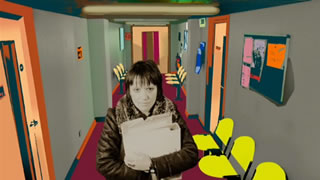 Go to main content
Go to main content
Archive Website of the UK government
Please note that this website has a UK government accesskeys system.
Main menu
Page menu
Home and community

Video: when you arrive for your hearing
Watch a video that will let you know what to expect when you arrive at court and you are waiting for your hearing. Find out what may happen in your court hearing, including decisions the judge could make.
Can't see the video?

To play this video you need Adobe Flash Player version 9 or higher on your computer and have JavaScript enabled on your browser. Our Help with video files page gives advice if you are unsure how to do this. The Flash software is free.
Going to court for a repossession order - what happens on the day
Find out what should happen in your court hearing, including decisions the judge could make.
Text version

Scene: A corridor with a doorway at the end. The defendant (the person who the mortgage lender or landlord is taking to court) is walking along the corridor towards the camera. You follow her down the corridor into another room.
Narrator: On arrival at court you will be directed to a waiting room.
Scene: From inside the waiting room, you see people sitting down and the faces of those waiting. The defendant arrives, walks to a notice board and checks the court cases that are listed there. You see the list from over the defendant’s shoulder.
Narrator: A list of hearings that the judge will hear that day is normally pinned to a notice board in the waiting area. If you are an unrepresented claimant or defendant, you should check the list when you arrive at court to see when your case is scheduled to be heard. If you have legal representation, your advisor will normally do this on your behalf.
Scene: The usher’s desk.
Narrator: When you arrive you should also make yourself known to the court usher so that he or she knows that you have arrived and are waiting for your case to be called. If you don’t do this you risk missing the hearing. Similarly, if you have to leave the waiting room for a comfort break or some other reason you should let the usher know that you need to leave for a short period of time. This means that if the judge calls your case when you’ve left for a short comfort break the usher will know about your whereabouts. Again, if you don’t let the usher know there’s a risk that you could miss your hearing.
Scene: A claimant (the person who is taking the defendant to court) stands in doorway with cigarette in hand, ready to light it. He walks away.
Scene: Inside the waiting room, the claimant and defendant are seated opposite each other. They talk.
Narrator: While you wait for your case to be called, there may also be an opportunity to negotiate with the other party if you feel inclined to do so - by talking to them direct or to their representative. Remember you can at any stage try to reach an agreement with other party to settle the case. Given the opportunity, many people will be willing to discuss the case with you to see if there is some way to resolve the dispute. Remember, you can agree with the other party to settle the case at any time.
Scene: The claimant and defendant lean forward and shake hands.
Going to court for a repossession order - what happens on the day
Find out what should happen at your court hearing, including decisions the judge could make.
 Facebook
Facebook Twitter
Twitter StumbleUpon
StumbleUpon Delicious
Delicious Reddit
Reddit